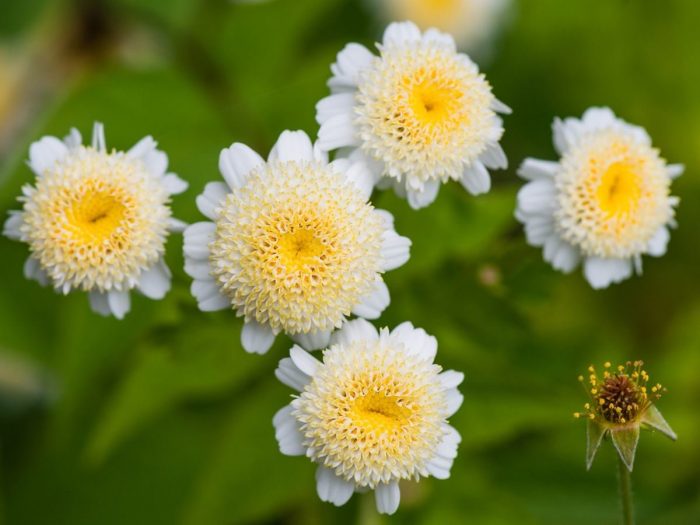Some of the most unique health benefits of feverfew include its ability to treat headaches, relieve stress, lower inflammation, reduce pain, break fever, ease menstrual discomfort, increase appetite, and boost respiratory health.
What is Feverfew?
While some people grow feverfew as an ornamental flower, due to its aesthetically appealing flowers, this plant scientifically known as Tanacetum parthenium is far more commonly used in traditional medicine and modern herbal therapies. These are hardy flowers and can often spread to large areas of land quickly, which is why some cultures see it as an invasive weed. However, people who recognize the value of feverfew appreciate this durable and resilient nature. Native to Eurasia, feverfew now enjoys a global presence and can be found on all major continents. [1]
Research on feverfew has been extensive, but some of the medicinal claims have been controversial. Parthenolide is the active ingredient that receives the most attention, but feverfew also contains a variety of oils and tannins that also have effects on human health. In terms of application, it can be administered as its dry or fresh form, but extracts of the volatile oils are also used for skin washes, tinctures, and pill supplements. Despite the many potential benefits of feverfew, use should be closely monitored and overseen by a trained professional, as it can interact with other medicines or treatments in many ways, some of which can be dangerous. Now, let’s take a more in-depth look at the many health benefits of feverfew. [2]

People take feverfew extract by mouth for the prevention and treatment of migraine headaches. Photo Credit: Shutterstock
Health Benefits of Feverfew
Health benefits of feverfew includes:
Migraine Relief
The oldest and most commonly praised benefit of feverfew is its clear effect on headaches and migraines. One of the effects of the active ingredients in it is its prevention of platelet build-up in capillaries and blood vessels. This is what causes tension in the cardiovascular system and causes headaches and migraines. By relieving and relaxing these vessels, feverfew can quickly eliminate these painful conditions. [3]
Anxiety and Stress
Although the pathway for this particular benefit is not fully understood, feverfew has been known to reduce stress and alleviate anxiety in some users. This is very important for those who suffer from chronic stress, as the presence of stress hormones in the body can be dangerous over long periods. [4]
Lower Inflammation
Some of the volatile compounds in feverfew have anti-inflammatory abilities, which effectively reduces inflammation throughout the body. For those who suffer from chronic joint pain, arthritis, gout, and other inflammatory conditions, herbal treatment with feverfew is a painless and effective solution. [5]
Pain Reduction
This is closely related to the anti-inflammatory effects of feverfew, but any analgesic substance deserves some recognition. For thousands of years, feverfew has been used to prevent pain throughout the body, not just the pain of headaches and migraines. Following surgery or an injury, it can be successfully utilized for rapid and long-lasting relief. [6]
Fever Symptoms
Traditionally, feverfew has been used to break and eliminate fevers. The name of the plant should be some indication of this ability. If you are suffering from a fever, whether it is linked to another more serious illness or not, it can help to promote sweating and eliminate toxins from the body, speeding the healing process and reducing inflammation. [7]
Menstrual Discomfort
One of the popular uses of feverfew is in the reduction of discomfort during menstruation. For billions of women around the world, menstruation can be a painful monthly occurrence that includes cramps, bloating, hormonal swings, pain, and excessive bleeding. It can effectively lower inflammation, eliminate cramps, and induce calm to reduce mood swings and anxiety. [8]
Appetite Booster
For people trying to gain weight or recovering from an injury/surgery, increasing one’s appetite can be very important. Feverfew has been linked to certain hormonal activity that induces hunger. While this may not be ideal for people trying to stay on a diet, it can certainly help the healing process and weight gain efforts for those individuals who may be underweight or calorie-deficient. [9]
Respiratory Function
The soothing ability of feverfew also extends to the respiratory tract, where this herb is able to reduce inflammation and irritation, which can often exacerbate conditions like asthma or coughing. By allowing the respiratory tracts to relax, it can help soothe these symptoms and improve overall respiratory health. [10]
Skin Guard
One of the more recent health benefits of feverfew is its role in skin health. Research is ongoing on the full effects of feverfew on the skin, but when it comes to dermatitis and other common forms of irritation, it has been shown to improve symptoms when topically applied.
Heart Health
Feverfew can inhibit the production of certain prostaglandins in the body that are responsible for increasing blood pressure. By reducing symptoms of hypertension, feverfew can protect overall heart health and lower the chances of experiencing atherosclerosis, and the consequent heart attacks and strokes linked to that particular blockage of the cardiovascular system. [11]
A Final Word of Warning
Feverfew is closely related to the ragweed family, which is a common allergen for many people. If you are allergic to plants in the ragweed family, feverfew should not be used. Common side effects include mouth ulcers in certain people, and if this occurs, discontinue use and see a medical professional. This herb should also not be used while pregnant, despite its analgesic and soothing qualities. As always, consult a medical professional or a trained herbalist before adding a new element to your herbal health regimen, as there is always the chance of negative pharmaceutical interactions with such powerful herbs. [12]
